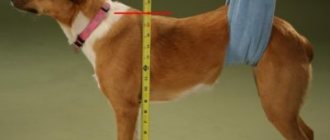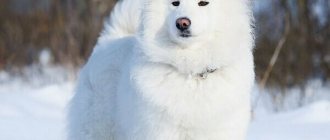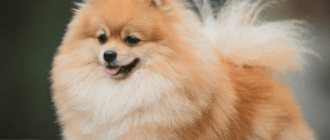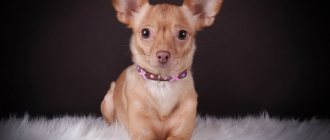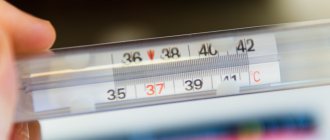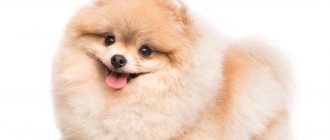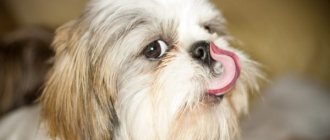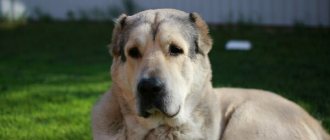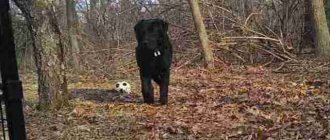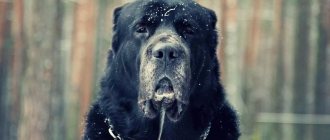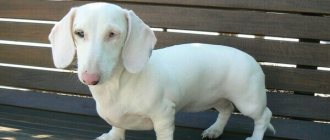Taking into account the pet’s parameters is necessary to monitor its development, determine compliance with the breed’s exterior, and calculate medication doses.
To select the correct collar, harness, or winter overalls, you need to measure your height at the withers.
Not all breeders know how to correctly determine this indicator. It is not difficult to learn this if you follow the basic techniques and follow the instructions.
When to correctly determine the location of the withers
The height of the withers is a necessary parameter for dogs. It is measured at various exhibitions and competitions. The indicator is also necessary in other cases.
When applying flea drops
Many antiparasitic drugs are applied to the withers. Since this is the highest point of the body, the animal cannot reach it on its own, and the risk of toxic substances entering the body is eliminated.
Insecticides are slowly absorbed through the pores of the skin on the nape of the neck, which reduces their side effects. The presence of blood vessels under the skin facilitates the distribution of the active substance throughout the body through the bloodstream.
When giving injections
The skin here is elastic, does not have increased sensitivity, and bundles of blood vessels connect here. 90% of all veterinary drugs are administered to dogs in this place: the procedure is painless, the drugs quickly enter the bloodstream.
It is quite difficult for a tailed friend to bite a veterinarian’s hand when he is holding him by the scruff of the neck.
To control the growth and development of your pet
All dog breeds meet certain standards. The adult puppy is measured to determine if he is developing properly.
Any deviations from the norm indicate diseases and a lack of nutrients in the diet.
Problems with the spine, curvature of the back, and developmental defects are determined after measuring height.
For accessories
Growth is an important parameter that you cannot do without.
A collar, harness, warm clothes, veterinary collar, and carrier are chosen based on this indicator. If their size does not correspond to the animal, then the pet will experience discomfort and the skin will chafe.
A large collar or collar is also useless: the dog can break free at any moment.
At exhibitions and competitions
If the dog belongs to the show class species, all its dimensions must correspond to the generally accepted exterior of the breed. Any deviations are not considered the norm; such an individual may be rejected and will not be allowed to breed.
In sports dogs participating in competitions, the potential jump height is determined by the height at the withers.
Collar size chart
To select the correct collar size, measure the circumference of your neck with a tailor's tape, placing two fingers under it. Since there are additional holes on the collar tape, add 5-7 cm to the result. It is important that the accessory is not too short and does not restrict breathing.
The size chart for dog collars uses the same designations as socks.
| Designations | Collar length, cm |
| XXS | 25 |
| XS | 30 |
| S | 37 |
| M | 42 |
| L | 51 |
| XL | 56 |
| 2XL | 61 |
| 3XL | 66 |
I hope that the article was useful to you. I will answer questions in the comments.
Rules followed when measuring a dog
To carry out accurate measurements, the help of a person with whom the dog can easily communicate is important. The assistant holds the animal, and the owner makes the calculations.
Measuring device
Dog handlers recommend using a special device - a height meter. If you don't have one, you will need a ruler (measuring tape), a level and a pencil.
Industrial height meters are equipped with a level and a clamp; their readings are more accurate.
At home, you can make a stadiometer yourself. To do this, take 2 wooden slats 3 cm wide, the length of one should be 25 cm, and the other 5 cm. They are glued together so that they form a right angle or the letter “G”.
A measuring tape is glued along the 5-centimeter strip, and a weight is hung on its end for convenience.
How to find the average
The dog is called, the assistant fixes it in one position. The long part of the stadiometer is placed on the dog’s withers; the short strip with the measuring tape is located along the body. The device must be positioned strictly vertically.
Measurements are carried out 3 or 4 times, this result is considered correct. During a one-time measurement, a slight deflection of the dog’s pasterns can significantly distort the results.
The interval between measurements is 30 seconds or 1 minute. All indicators are added up and divided by the number of measurements taken.
For example: the height of the dog at the withers at the first measurement is 25 cm, at the second - 24, at the third - 24.5 cm. Calculations: (25+24+24.5): 3=24.5.
Stand as a prerequisite
The dog's height is measured in a calm, standing position. The floor surface must be flat and hard. The dog's paws are straight, but not tense.
Expert opinion
Panteleeva Irina Petrovna
Breeder, 11 years experience.
Young, active individuals are gradually accustomed to the procedure: they must behave calmly. The dog is fixed in the exhibition stand.
Correct application of measuring instruments
The most accurate results are shown by a professional stadiometer, but dog breeders do not always have one.
In its absence, measurements are made as follows:
- The pet is placed on a flat surface and fixed.
- Determine the location of the withers.
- Place a book, construction meter, level or any other flat object on top of the blades.
- Using a measuring tape or ruler, measure the height of the pet from the scruff of the neck to the floor.
Important! The tool must be strictly straight (it is better to use a plastic or metal ruler).
There should be no soft coverings, baseboards, or protrusions on the floor.
Shoe size chart
If the attitude towards your pet’s clothing is ambiguous, even more so, questions arise: why are shoes needed? What is this? Glamorous entertainment for eccentric owners? Protecting pampered pets from dirt and cold? Nature has provided dog paws with adaptations to withstand adverse environmental conditions. Only man has changed the environment itself. In winter, city streets are treated with deicing agents - chemically aggressive substances that corrode the skin of dog paws. Shoes will protect your pet from cuts and bruises even in good weather.
The second reason “in favor” is the reluctance to drag dirt into the apartment. Owners have a choice: wash their paws in a basin after every walk, purchase a paw washer, or train their pet to wear shoes.
Just like for humans, boots and socks are provided for dogs. The latter are necessary to protect dog paws from slippery floors and floors, as well as upholstered furniture from paws and sharp claws. In addition, socks are an intermediate stage in getting used to wearing shoes or boots.
How to measure your dog to find the right shoes? You need to measure the size of your limbs. To do this, place your pet’s paw on a clean sheet of paper, outline the perimeter of the limbs, as shown in the figure:
There is another way: measure the paw with a tailor's centimeter by weight. In this case, you need to take into account the length of the claws and add 0.5 cm to the result. But I recommend the option with drawing on paper, as it is more accurate and reliable.
Based on the measurement results, purchase shoes according to the table indicators:
| Boot sizes | Sock sizes | Paw length, cm | Paw width, cm |
| 0 | S | 3,5 | 3 |
| 1 | S | 4 | 3,5 |
| 2 | S.M. | 4,5 | 4 |
| 3 | M | 5 | 4,5 |
| 4 | L | 5,5 | 5 |
| 5 | L-XL | 6 | 5,5 |
| 6 | XL | 6,5 | 6 |
| 7 | 7 | 6,5 | |
| 8 | 8 | 7 | |
| 9 | 9 | 8 | |
| 10 | 10 | 9 |
The table shows average indicators. Product information may vary from manufacturer to manufacturer, so to find out the shoe size for your pet, I recommend consulting with the seller.
The size that is called height at the withers
By the age of 2–3 years, the dog’s skeleton is fully formed. At this time, measurements will be more accurate than at an earlier age.
Dog classification:
- small breeds - up to 28 cm (dachshunds, spitz, toy terriers, chihuahuas, pinschers, beagles, corgis);
- medium dogs - from 28 cm to 55 cm (bulldogs, spaniels, hounds, greyhounds, bull terriers);
- large breeds of dogs - more than 55 cm at the withers (mastiffs, Newfoundlands, Caucasian Shepherds, Great Danes, St. Bernards, Labradors).
Dogs that do not have a breed can have any height regardless of weight.
For purebred dogs, the indicator must meet established standards. If dogs of different breeds were allowed to breed puppies, the indicator may undergo changes in one period of time.
Exact position of the desired point
If you draw a vertical line along the dog's front legs, and a horizontal line over his spine, then the intersection of these lines will indicate the exact location of the withers. This area (protruding tubercle) is located between your pet's shoulder blades. It is easy to lift the skin in this area with your hand.
The withers are located just behind the dog's neck and consist of the first five thoracic spines. The mother carries the puppies by holding them by the withers.
In a healthy, properly developed dog of any breed, the withers are the highest part of the body. That is why growth is measured based on this point.
Clothing size charts
The manufacturer of each type of clothing indicates its own parameters. Average indicative data is shown in tables designed for pets of large, medium or small breeds. There is a separate table for dogs with a non-standard body shape.
Table for determining clothing sizes for pugs, as well as pets of large and medium breeds:
| Designation | Dimensions, mm | Breed (approximately!) | |
| Back length | Bust | ||
| A0 | 350 | 550 | Scottish Terrier, West Highland White Terrier |
| A1 | 300 | 500 | French bulldogs, pugs |
| A2 | 350 | 550 | American and English Cocker Spaniels, Beagles, Fox Terriers, Miniature Schnauzers, Shelties, Medium Spitz, Chinese Crested |
| A3 | 400 | 600 | |
| B1 | 400 | 700 | Bull Terriers, Staffordshire, Wheaten, Kerry Blue Terriers, Collies, Shar-Peis |
| B2 | 450 | 750 | |
| B3 | 500 | 800 | |
| C1 | 550 | 750 | Labradors, Huskies, Dobermans, Golden Retrievers, Boxers, Akitas |
| C2 | 600 | 800 | |
| C3 | 650 | 850 | |
| D1 | 700 | 950 | Rottweilers, Great Danes, Boxers, St. Bernards, |
| D2 | 750 | 1000 | Dobermans, Cane Corsos, Bullmastiffs, Black Terriers, Great Danes |
But how to choose the appropriate sizes of overalls if one of the two parameters - torso length or chest girth - does not match the data in the table? For example, with a length of 300 and a girth of 550 mm, choose size A2 rather than A1, otherwise the clothes will be tight.
Clothing size chart for small dogs:
| Designation | Dimensions, mm | Breed (approximately!) | |
| Back length | Bust | ||
| 8 | 210 | 270 | Toy Terrier, Yorkie, Chihuahua, Maltese |
| 10 | 240 | 320 | Yorkie, Chihuahua, Pomeranian, Maltese |
| 10Chh | 240 | 340 | Chihuahua, Papillon, Pomeranian, |
| 12 | 270 | 360 | Yorkie, Chihuahua, Pomeranian, Papillon, |
| 12Chh | 270 | 380 | Chihuahua, Toy Poodle, Papillon, Pomeranian, |
| 14 | 300 | 400 | Chihuahua, Miniature Poodle, Petit Brabançon, Pomeranian Spitz, Brussels Griffon, |
| 16 | 330 | 440 | Small Spitz, Brussels Griffon, Miniature Poodle, Miniature Pinzer, Brabançon, Chinese Crested |
| 18 | 360 | 480 | Spitz, Miniature Schnauzer, Chinese Crested, Fox Terrier |
| 20 | 390 | 520 | Spitz, Miniature Schnauzer, Chinese Crested Cocker Spaniel, Fox Terrier |
| 22 | 420 | 560 | Chinese Crested, Cocker Spaniel, Miniature Schnauzer, Basenji, Fox Terrier |
Clothing size chart for Welsh Corgis and Dachshunds
| Designation | Dimensions, mm | Breed (approximately!) | |
| Back length | Bust | ||
| TM1 | 340 | 400 | Miniature Dachshund |
| TM2 | 390 | 430 | |
| TC1 | 440 | 530 | Standard fee |
| TC2 | 490 | 550 | |
| K39 | 390 | 550 | Welsh Corgi |
| K43 | 430 | 600 | |
To choose the right clothes for your pet, you need to determine what it is needed for. In most cases, you choose clothes for your pet to look attractive when paired with it. But do not harm the dog.
Most buyers of dog clothes believe that in this way they protect their pet from dirt, dust, and precipitation. Pay attention to the length of the wool; do not buy a suit with insulation, so as not to develop overheating, which is more dangerous than hypothermia.
Overalls look good on small dogs. There is a problem with large breeds. The length of the back and the width of the chest do not match the tabular data. In such a situation, I recommend purchasing a jacket or sweatshirt. The products do not have pants. Which means there are restrictions on length. The main thing is that the chest circumference is suitable.
If you use the table to choose a clothing size, be guided not by the breed, but by the actual body length and chest circumference.
An alternative size chart uses the following symbols:
- X (extra) - very;
- S (short) - small;
- M (medium) - average;
- L (large) - large.
The combination XS means very small, XL means very large, XXL means too large. This table does not take into account breed characteristics, but it makes it easier to choose clothes not only according to measurements, but also according to the weight of the pet.
Universal size chart for dogs:
| Size | Back length, cm | Chest circumference, cm | Live weight, kg |
| XS | 19,5 | 28 | 1,5 |
| S | 23,5 | 32,5 | 2,5 |
| M | 28 | 37,5 | 3,5 |
| L | 33 | 43 | 5 |
| XL | 38,5 | 48 | 7 |
| XXL (2XL) | 44,5 | 52,5 | 9 |
| XXXL (3XL) | 50,5 | 58 | 12,5 |
| XXXXL (4XL) | 57 | 65,5 | 20 |
| XXXXXL (5XL) | 64 | 75,5 | 30 |
| XXXXXL (6XL) | 70,5 | 85,5 | 40 |
P Correct measurements of your pet to purchase a carrier
If the dog is small, then the owners can successfully use a special carrier - an excellent device for transporting their four-legged friend. It is convenient to take on a trip, use it to deliver your pet to an exhibition, to a veterinary clinic, etc.
While in a carrier, the dog is less stressed and does not get its paws dirty. Naturally, it is much more convenient and humane to carry a sick dog in such a device, which reduces pain from shaking or contact with human hands.
But before purchasing a suitable carrier, you should measure your four-legged friend, otherwise a design that is too tight may cause discomfort for your pet or may not be suitable for transporting him at all. It is important that the dog has the opportunity to change his body position if the need arises. In addition, the material must withstand the weight of the quadruped. The owner needs to measure the dog's height at the withers, as well as the length of its body from the tip of the nose to the base of the tail.
Liver
The liver consists of the right lateral, right medial, left lateral, left medial, quadrate and caudate lobes; The caudate lobe consists of the caudate and mastoid processes. Ultrasonographically, the lobes cannot be differentiated. On the contrary, the liver is visualized as an integral homogeneous structure that normally contains branching portal veins. A normal ultrasound appearance of the liver does not exclude infiltrative diseases in dogs and cats.
Figure 1. (A) Longitudinal image of a dog's liver. The structure and echogenicity of the liver are normal with clear walls of the portal veins (hyperechoic) and hepatic veins (isoechoic). The curvilinear hyperechoic line separating the cranial periphery of the liver in the far field represents the reflected lung/diaphragm-liver interface. (B) Longitudinal scan of a cat's liver.
Note the hyperechoic falciform ligament fat in the near field (red arrow) with an echogenic line defining the origin of the liver parenchyma
Dog
The canine liver (Figure 1A) is hypoechoic to the adjacent spleen. Falciform ligament fat in dogs is not a reliable indicator of the overall echogenicity of the liver, as it may appear hypo-, iso-, or hyperechoic relative to the normal liver. The portal veins have distinct hyperechoic walls.
Figure 2. Longitudinal image of a cat liver. The liver is hypoechoic to the fat of the falciform ligament. The walls of the blood vessels are not as clearly visible as in a dog.
Cat
The gallbladder is a thin-walled (<1 mm), fluid-filled, anechoic structure (Figure 3). Fullness varies depending on when the last meal was and the fat content of it.
Unlike dogs, cat liver (Figure 1B) is typically isoechoic to the fat of the falciform ligament, which is thicker than that of dogs. However, the liver becomes hyperechoic in clinically obese cats secondary to fatty liver or lipidosis; or hypoechoic, as in active hepatitis or lymphoma (Fig. 2). Intrahepatic portal veins are less prominent in cats than in dogs.
Foreign body in a dog. Treatment Options
There are several treatment options depending on your dog's condition.
If you have recently swallowed foreign objects, you may try to induce vomiting. It is also necessary to remove mineral oil, which facilitates the passage of foreign bodies through the gastrointestinal tract within 48 hours. Some objects can be removed using an endoscope. If the animal has symptoms such as vomiting blood or severe pain, then intravenous infusions and painkillers are necessary. Your veterinarian will suggest admitting your dog to the clinic for observation. The decision to operate is usually made on the basis of x-rays and ultrasound results. A blockage in the intestines or stomach can reduce blood flow to the GI tissues, which can become necrotic. If the foreign body is in the stomach or intestines, the object is removed by making an incision in the intestines or stomach. If there are necrotic tissues and parts of the intestine, they are also removed.
After the operation, intensive therapy is carried out with intravenous fluids, painkillers and antibiotics are administered. Feeding the dog after surgery begins 1 to 2 days later. It is advisable to use special diets for nutrition at first.
Necessary parameters for selecting accessories
When choosing clothes for your pet, you need to correctly determine its size. A mistake can lead to the fact that the chosen clothing will restrict the dog’s movements or dangle on it, causing irritation. This may cause the dog to completely refuse to wear the carefully chosen warm overalls.
To select dog accessories, you may need to not only measure the dog's height at the withers, but also chest circumference, neck circumference, head circumference and waist circumference. If you purchase socks or shoes, you will also need the circumference of the pastern and the size of the paw. In the production of dog accessories, there are a number of size tables that make the choice much easier for the owner. These tables are organized by breed and category.
Dog measurements for choosing accessories
Read also: How to calculate the circumference of a circle
When choosing accessories and clothing for miniature pets, you should focus on a separate size chart. The most commonly used table is provided by the famous brand ForMyDogs. The size range in it ranges from 8 to 20. At the same time, there are 2 additional sub-sizes - 10/chh and 12/chh. They assume the presence of two additional centimeters in chest volume with a standard back length.
Gallbladder
The gallbladder is a thin-walled (<1 mm), fluid-filled, anechoic structure (Figure 3). Fullness varies depending on when the last meal was and the fat content of it.
Figure 3. (A) Short axis image of a dog's liver.
Note the round, thin-walled, anechoic gallbladder located on the right side of the liver. Bile in the gallbladder is anechoic
The liquid nature of the bleb contents results in a distal amplification of sound noted in the far field of the image (white arrow). (B) Longitudinal scan of the cat's liver. Note the thin-walled bilobed gallbladder (*) with mirror image artifact on the opposite side of the diaphragm.
Dog
The neck of the gallbladder normally narrows; the cystic and common bile ducts are not traced to the level of the duodenal papilla in dogs (Fig. 4). Echogenic content in the gallbladder is considered normal in dogs, but is observed to a greater extent in dogs with Cushing's disease. Typically, the position of echogenic contents in the gallbladder depends on gravity (far field).
Cat
The gallbladder may be bilobed in cats as a variant of the anatomical norm (Figure 3B). In cats, the cystic and common bile ducts can normally be traced to the level of the major duodenal papilla and have a diameter of 2 to 3 mm (Figure 5). If a hyperechoic deposit is present in a cat's gallbladder, in combination with wall thickening, differential diagnoses would include cholecystitis or cholangiohepatitis; The normal feline gallbladder usually does not contain echogenic deposits.
Figure 4. Short axis view of the canine duodenal papilla (white arrow) at the level of the descending duodenum.
Note the normal focal thickening of the hyperechoic submucosal layer of the duodenum at the level of the confluence of the main duodenal papilla
Figure 5. Short axis scan showing a cat's cystic duct at the level of the gallbladder.
Note the relatively dilated duct (normal
Pancreas
Figure 12. (A) Transverse scan of the right lobe of the pancreas in a normal dog.
Note the location in relation to the right kidney (RK) and descending duodenum (DUO). The duodenum is usually located lateral to the right lobe of the pancreas, and the right kidney is usually located medial to the right lobe of the pancreas
(B) Longitudinal scan of the left lobe (transducer position relative to the abdominal wall is transverse) of the cat's pancreas is normal. Note the position of the pancreas (between the calipers) relative to the left kidney (LK) and the visualization of the duct (an anechoic tubular structure located in the center of the pancreas). The left lobe of the pancreas is usually located craniolateral to the cranial pole of the left kidney and medial to the body of the spleen, between the caudal border of the stomach and the cranial border of the transverse colon.
The pancreas in dogs and cats may be isoechoic to the surrounding mesenteric fat and is therefore poorly visualized. Reducing the dynamic range of the image to create greater contrast may help identify the pancreas as it becomes more hypoechoic relative to the surrounding mesenteric fat.
Dog
In dogs, the right lobe of the pancreas (Fig. 12A) is easier to identify based on its larger size relative to the left lobe and proximity to the descending duodenum. The size of the pancreas varies depending on the size of the dog. Normally, the glandular duct is not detected on ultrasound. If the duct is present, it is visualized as two hyperechoic parallel lines in the center of the pancreas.
Cat
In cats, the left lobe of the pancreas (Fig. 12B) is more accessible for examination because it is larger than the right lobe. The descending duodenum is more difficult to identify in cats due to its more midline and dorsal location. The centrally located pancreatic duct is usually easily visualized and is used as a landmark to identify the pancreas. The diameter of the pancreatic duct increases with age in cats (Table 1).
Correlation with standard
Growth standards have been established for each breed of the dog family. As an example, here are the values typical for cables of common types:
- Dalmatian, 56-62 cm,
- Labrador Retriever, 56-57 cm,
- Great Dane, 80-90 cm,
- Saint Bernard, 70-90 cm,
- Giant Schnauzer, 60-70 cm,
- German boxer, 57-63 cm,
- beagle, 33-40 cm,
- Maltese, 21-25 cm.
The pet's height may not coincide with the standard if its mother and father belonged to different breeds. Unpredictable growth is also typical for outbred puppies: growing up, they can be much taller or shorter than their parents.
The tallest dog in the world, the Great Dane Zeus, is 111.8 cm tall at the withers. The god of canine Olympus lives in the American state of Michigan. Owners say that with a weight of 70 kg, the pet eats 14 kg of dog food per day. The barking giant does not fit in a passenger car, so for country trips I had to buy a truck.
How to measure an animal
In order to measure the height of your pet at the withers at home, you can make a simple device yourself. You will need two wooden blocks, one twenty-five centimeters in size, the other five centimeters. The wooden parts are glued together in the shape of the letter “L”. To a block of shorter length, along it, you need to glue a measuring tape. For ease of measurement, you can glue a weight to the bottom. Now you need to call the dog to you (it is better to carry out the manipulations with an assistant), put the pet in a calm position and put a device on the withers for measuring the long part. It is important that the measuring device is positioned strictly vertically.
You can measure height without special devices. To do this, apply a centimeter to the pet standing on a flat surface, to the highest point of the shoulder blade, where the dog’s withers are located, and the lower part of the measuring tape is lowered to the floor. The result obtained is the height of the animal. If the dog has long hair, spread the hair down to the skin and then apply a measuring tape.
It's even easier to measure your pet's height by holding a measuring board to it.
Types of outfits
Clothing for purebred small dogs comes in several types of products. Such wardrobe elements will help keep your pet warm in winter, while he will remain beautiful and stylish. The most common types of outfits include:
- blanket;
- kits;
- overalls.
A blanket is a small product that is put on the dog over the head. It will be an excellent alternative to various blouses that cannot be worn on a pet due to its excessive activity. The blanket does not hinder the dog’s movement, because it is located on the neck, covers part of the body and does not affect the paws. Depending on the gender of the dog, stores offer a variety of colors: blue, light blue, pink, yellow, green. You can also find original prints on the fabric, which will make your dog stylish on a walk.
Clothing sets for small dogs consist of several wardrobe elements: pants, as well as a sweater or jacket. The latest piece of dog fashion is usually made of waterproof fabric similar to a thick raincoat. It would be good if the bottom of the jacket was equipped with a warm lining for the cold season. Sweaters replace jackets; they are purchased for the off-season - for walks in spring and autumn. Pants are the favorite clothing of small dogs. They go great with a jacket or sweater, the only problem is putting the pants on your pet. Most dogs categorically refuse to wear this wardrobe item.
Jumpsuits are considered the most common types of outfits for modern miniature dogs. They are easy to put on, do not restrict your pet’s movements, and are made of protective fabric. In overalls, a terrier or Yorkie will be comfortable in winter, spring and summer. The pet will not get dirty and will come back from a walk clean and tidy. Overalls are equipped with zippers or buttons that fasten on the stomach or back.
